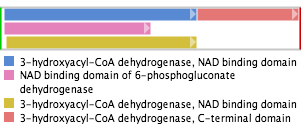Rv0468 - 3-hydroxybutyryl-CoA dehydrogenase fadB2

|
|
Protein Domains  |
| Gene Information | |
|---|---|
| Locus | Rv0468 |
| Symbol | fadB2 |
| Gene Name | 3-hydroxybutyryl-CoA dehydrogenase fadB2 |
| Location | 558895 - 559755 (+) |
| Species | Mycobacterium tuberculosis H37Rv complete genome. |
| Length | Gene:861 bp Protein:287 aa |
| External Links | Tuberculist Target Gene Information String Protein-Protein Interactions STITCH Chemical-Protein Interactions Search Google Scholar |
Orthologs

|
| Orthogroup Number | 34779 |
| Related Genes | Acel_0147 Acel_0658 BL0058 MAP3962 MAV_4681 Mkms_0650 ML2461 Mmcs_0637 MSMEG_0912 MT0484 MUL_4537 Mvan_0802 nfa52290 SAV1909 SAV2870 SAV2889 | Transcriptional Regulation |
| Operons | View gene in operon browser |
| Regulatory Network | |
| Expression Correlation |
Genes with Correlated Expression Scatterplot of Gene Expression |